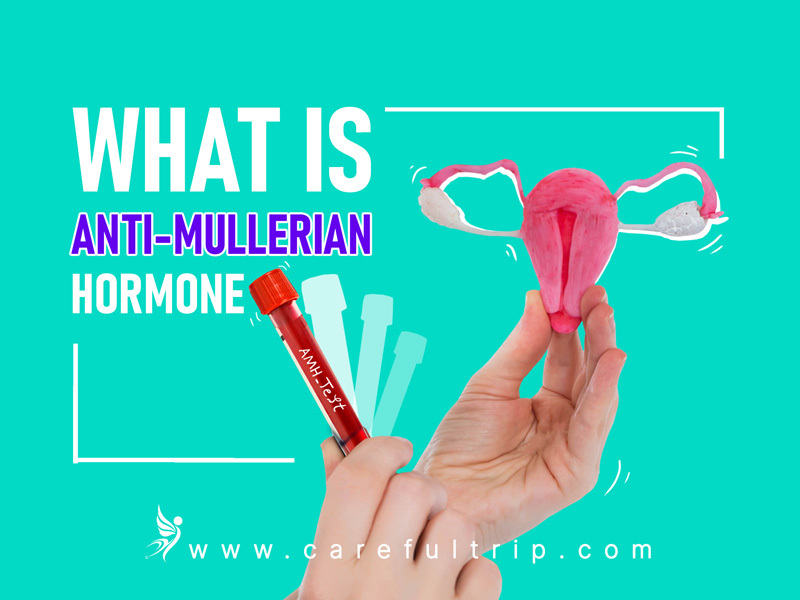
Anti-Müllerian hormone is a protein hormone generated by the testes and ovaries before birth that is essential in the development of the male reproductive system. Around eight weeks after conception, the human embryo has two sets of ducts, one of which can develop into the male reproductive system and the other into the female reproductive tract. If the fetus is genetically male, the embryonic testes will produce anti-Müllerian hormones (XY chromosomes). The Müllerian (female) ducts are destroyed by anti-Müllerian hormone, whereas the male (Wolffian) ducts are preserved by testosterone generated by the testes.
What Is the Purpose of Anti-Mullerian Hormone?
- AMH is essential for the development of the sex organs of the fetus when it is growing within the womb. Male newborns have greater levels of AMH because it suppresses the development of female reproductive organs. Female babies require only a small quantity of AMH to develop.
- Regulation of Steroid Production: During puberty and maturity, the ovaries and testes produce sex hormones under the control of the anti-Müllerian hormone.
- In the early stages of development, the anti-Müllerian hormone appears to considerably enhance the formation of ovarian follicles, which contain and sustain the eggs before fertilization in the ovaries.
For more information read:
What Is Ovarian Reserve and What Does It Mean?
Ovarian Reserve: AMH is produced by female ovarian follicle cells. Follicles are small sacs filled with fluid that store and release eggs in the ovary. If a woman has more ovarian follicles, her ovaries may release more anti-Müllerian hormones. AMH may be tested in the circulation to evaluate how many follicles remain in the ovaries, also known as ovarian reserve. In the following ways, ovarian reserve or egg production is connected to AMH levels. High AMH levels are associated with greater ovarian reserves and more eggs. Low AMH levels are associated with fewer eggs and a lower ovarian reserve.
What Happens if Levels of Anti-Mullerian Hormone Fluctuate by IVF in Iran?
- Anti-Müllerian Hormone Deficiency
- When the male fetus does not create enough anti-Müllerian hormone, the Müllerian ducts do not dissolve, resulting in persistent Müllerian duct syndrome. Patients with this condition have a masculine look, but they typically have undescended testes (cryptorchidism) and a low or nonexistent sperm count due to incorrect Wolffian duct development. Malformations of the vas deferens and epididymis have been related to this. This is a relatively rare condition.
- In women, because anti-Müllerian hormone is generated by ovarian follicles, measuring anti-Müllerian hormone levels in the blood can be used to evaluate ovarian reserve. Anti-Müllerian hormone levels are routinely used to predict a woman’s response to ovarian stimulation during in vitro fertilization (IVF) and to prescribe the hormone dosages to be used during the process.
The quantity of eggs in your ovary is simply reflected in your AMH level. You cannot use any drugs to make this number higher. Your ovary’s ability to produce eggs does not increase when your AMH level rises. This total quantity of eggs steadily diminishes throughout the course of your reproductive life since your ovary only multiplies eggs once before you are born.
- High Levels of Anti-Müllerian Hormone
- Women’s anti-Müllerian hormone levels peak around puberty. They stay rather steady until beyond menopause when follicles cease to exist and anti-Müllerian hormone levels fall. Anti-Müllerian hormone levels in women experiencing early ovarian failure may be lower than usual. High levels of anti-Müllerian hormone may be connected to polycystic ovarian syndrome (PCOS). However, anti-Müllerian hormone testing might be misleading and does not yield a definite diagnosis of premature ovarian failure or polycystic ovary syndrome.
For more information read:
What Exactly Is an Anti-Mullerian Hormone Test?
An AMH test is used to determine the level of anti-Müllerian hormone (AMH) in a woman’s blood. AMH testing is a blood test. A healthcare professional uses a small needle to take blood from a vein in the arm. The procedure is quite rapid and takes only a few minutes to finish.
A blood test called the Anti-Mullerian hormone level determines how many eggs are still in your ovary. This also goes by the name “ovarian reserve.” It doesn’t provide any information regarding the quality of your eggs. Your age will have the most impact on the quality of your eggs, which cannot be assessed unless the eggs are removed from your body and fertilization attempts are done.
CarefulTrip reminds you that AMH is generated by both males (those born as males) and females (those assigned females at birth). However, the test is most typically performed in women to indicate a woman’s reproductive health.
What Is the Anti-Mullerian Hormone Test Used For?
The AMH test for IVF in Iran can be used for the following purposes:
- An AMH test can tell you how many eggs a woman has left and if her ovaries are quickly aging. It might signal that the window of opportunity for conception is narrowing.
- An AMH test can also reveal how effectively women respond to injectable fertility medications that stimulate the ovaries to produce a large number of eggs in preparation for in vitro conception (IVF).
- AMH test to determine the presence of a granulosa cell tumor in an ovarian mass. AMH levels can also be checked to see if the treatment is working or if the tumor has returned.
- The AMH test is used to assess if an infant’s genital organs are male or female.
- It aids in determining the reason for amenorrhea, or the lack of menstruation. It is more prevalent in girls who did not begin menstruating by the age of 15 and in women who had skipped many cycles.
What Are the Anti-Mullerian Hormone Test’s Limitations?
- Although AMH is connected to egg count, it does not predict fertility (with or without therapies).
- It does not aid in the prediction of menopause.
The fact that your ovary can produce numerous eggs in the same treatment month is used in many of our procedures. Other animals, such as cats, dogs, and mice, ovulate many eggs at the same time, but a human ovary naturally (nearly usually) releases a single egg. Your ovary will produce many eggs as a result of taking fertility medicines, which we employ for IVF (in vitro fertilization) or Invoice cycles to collect plenty of eggs at once.
Checked results of Anti-Mullerian Hormone
A glycoprotein of the transforming growth factor (TGF), anti-Müllerian hormone (AMH) (TGF-P). AMH is essential for the Müllerian ducts to regress in the male embryo. Without it, Müllerian ducts do not develop into female inner reproductive organs. AMH acts as a biochemical indicator of testicular existence in cryptorchid males. AMH is created by the granulosa cells of the tiny follicles of the female ovary. Throughout a woman’s reproductive life, her serum AMH levels may be tracked to determine her ovarian follicular reserve. AMH is the most effective ovarian reserve measurement currently available for IVF in Iran and has a lot of clinical disorders.

